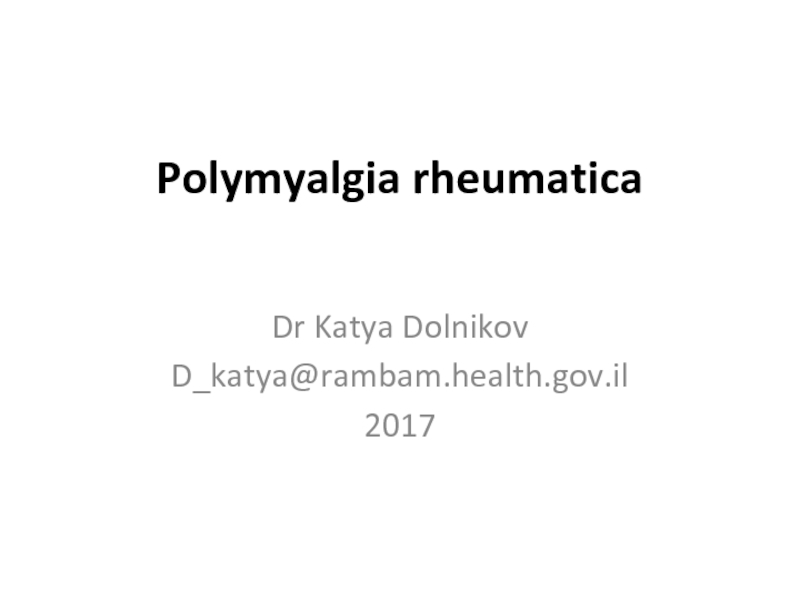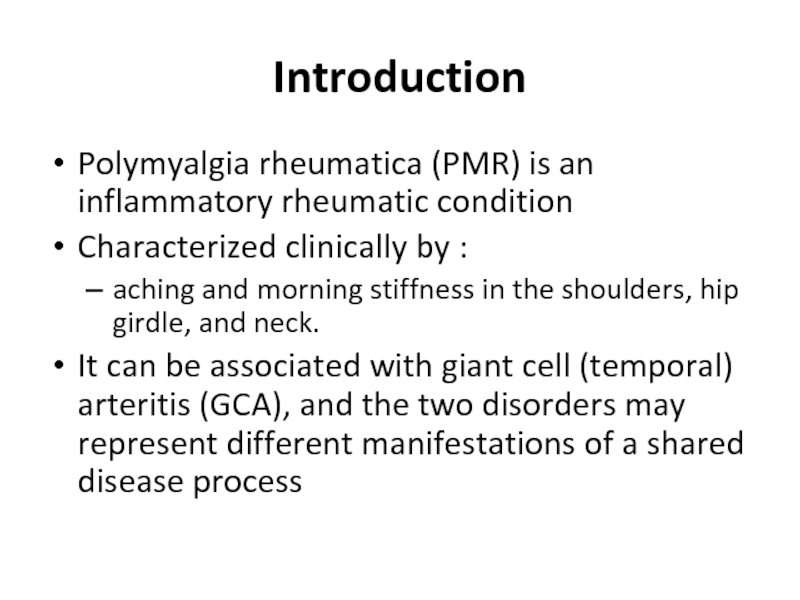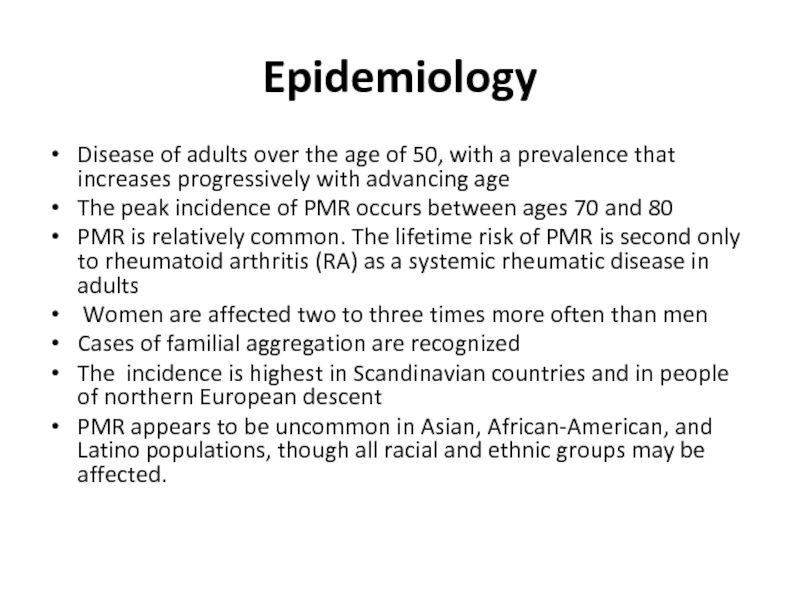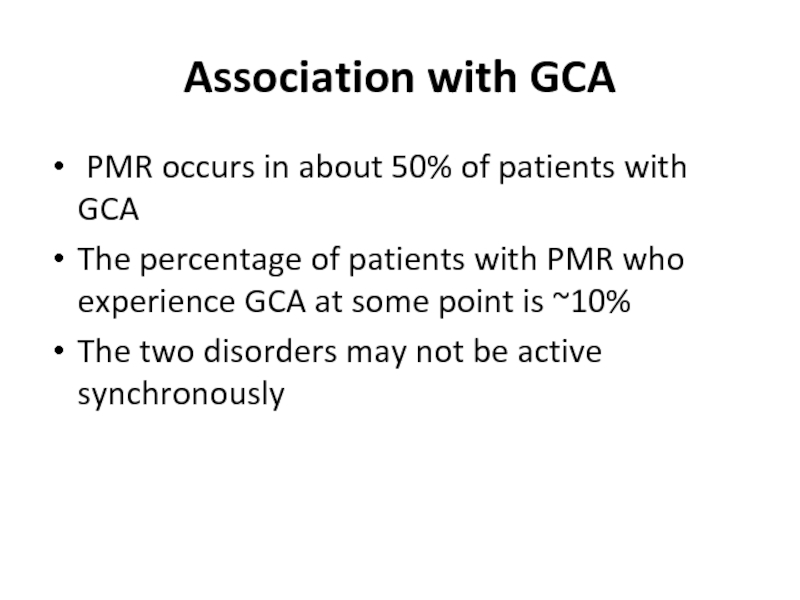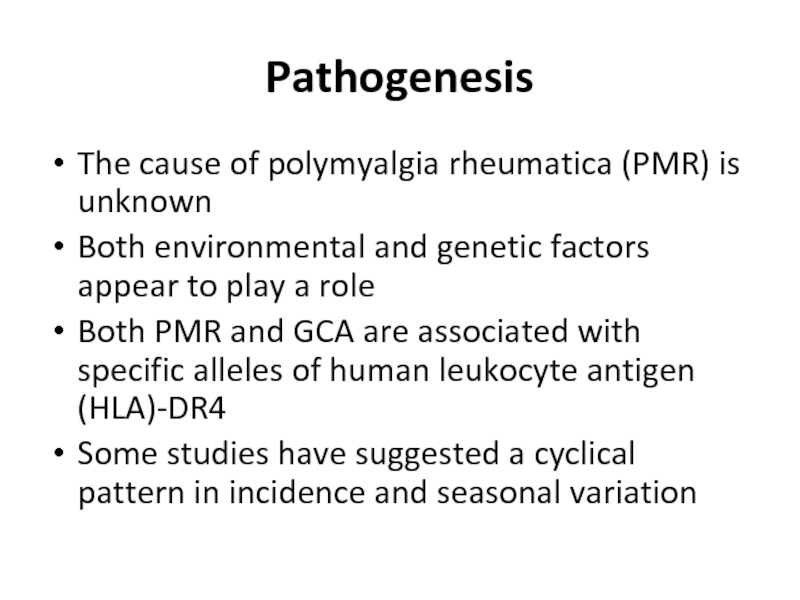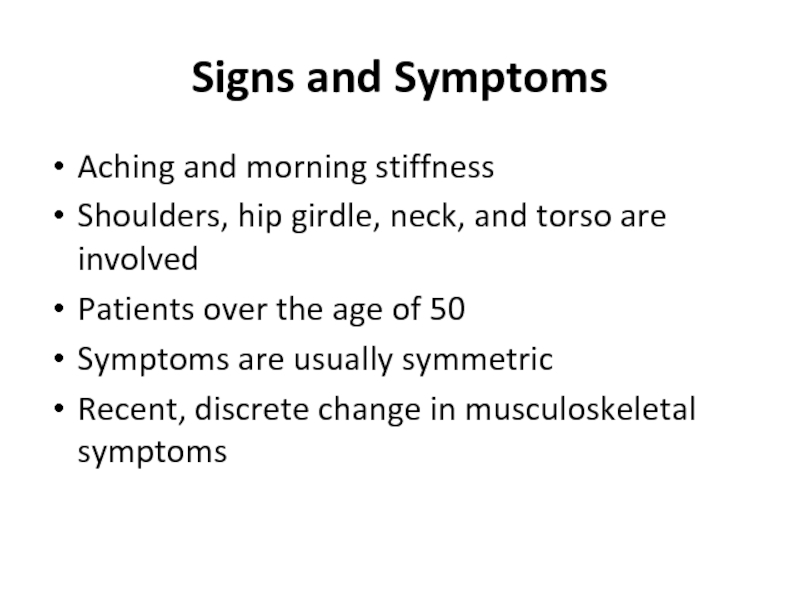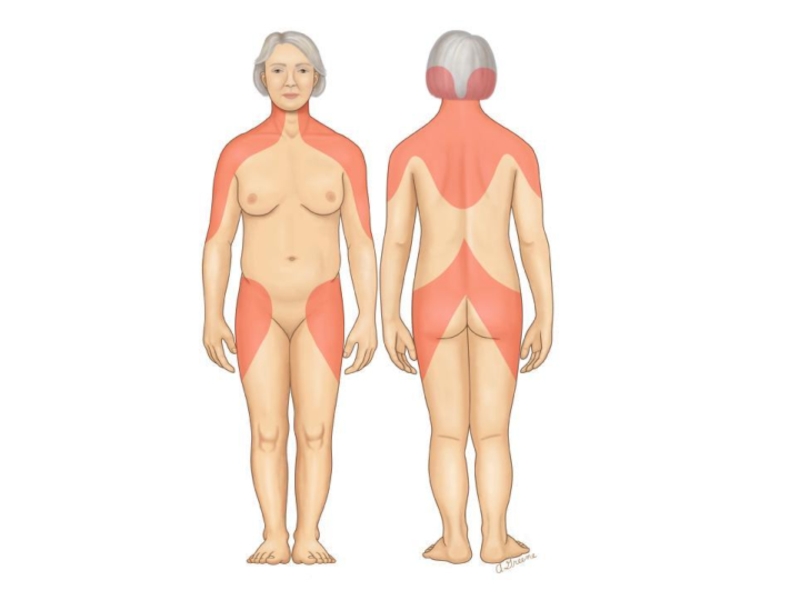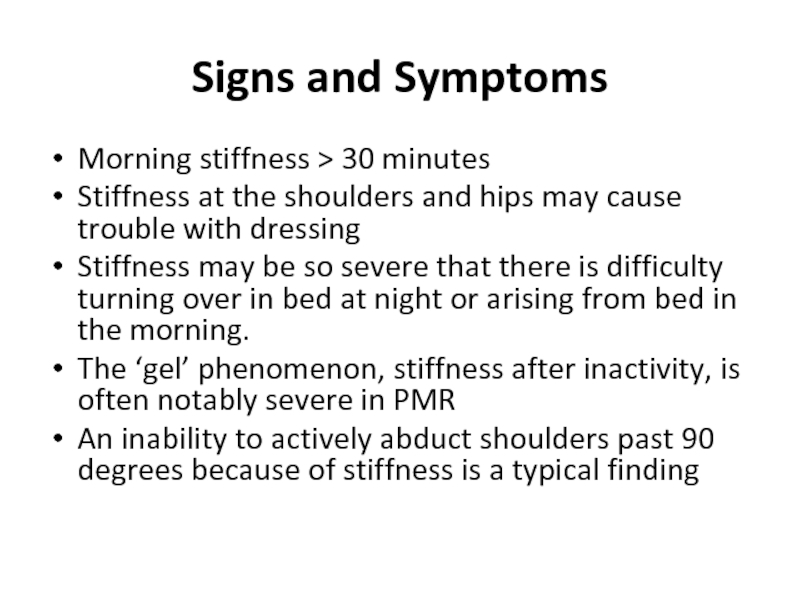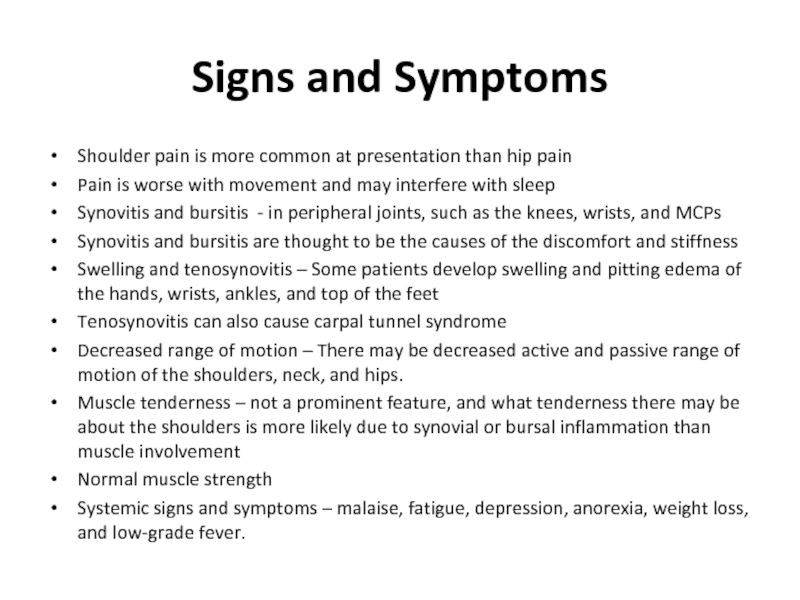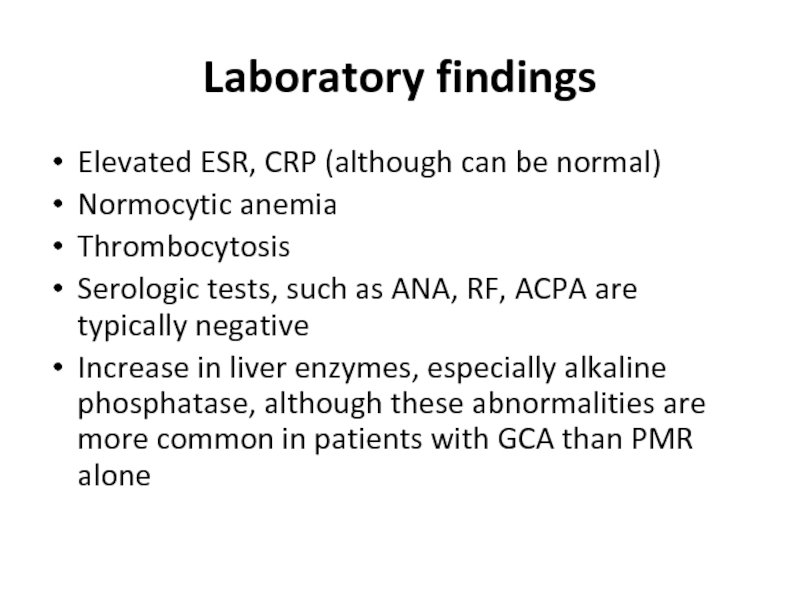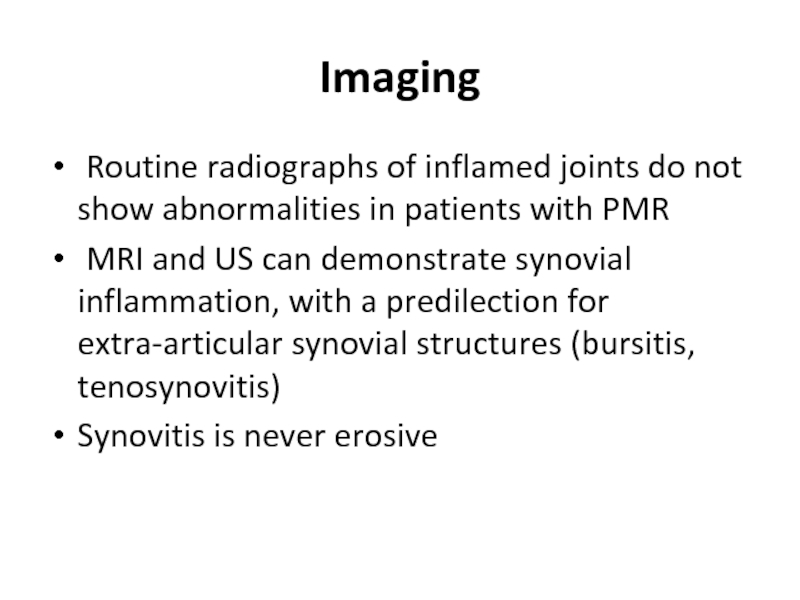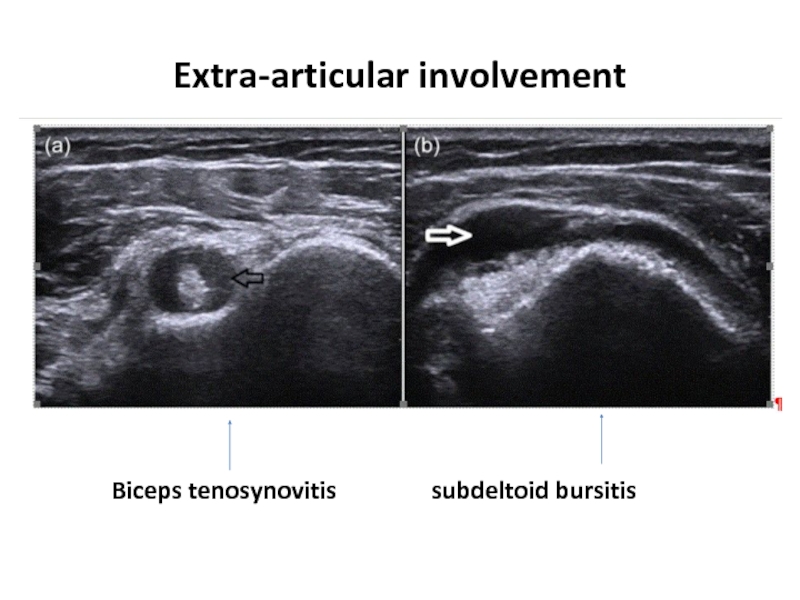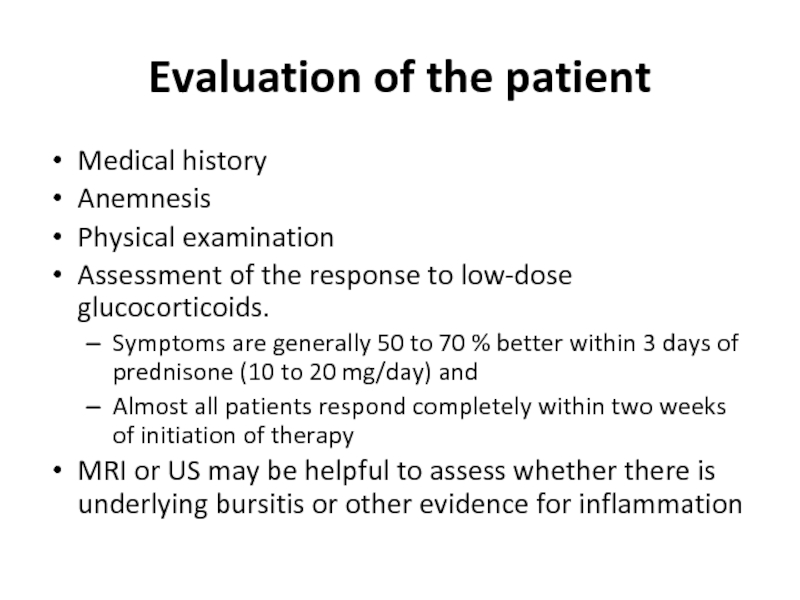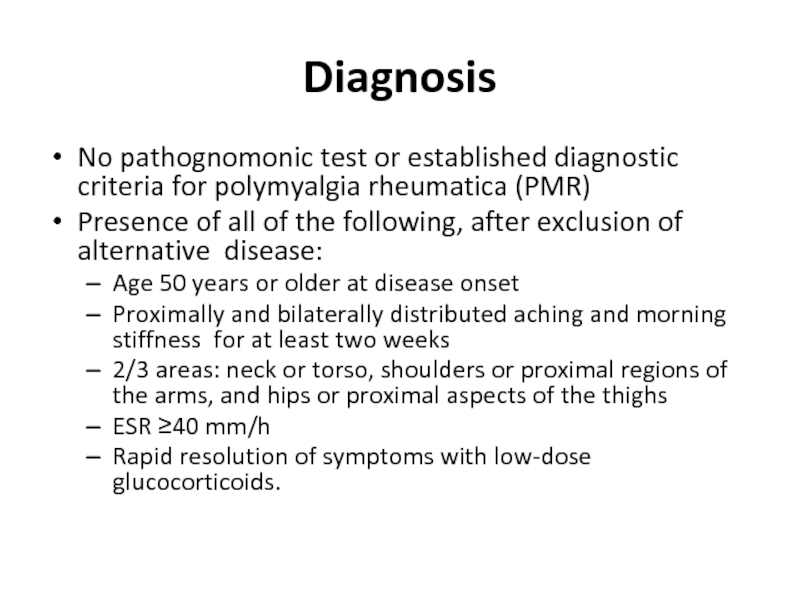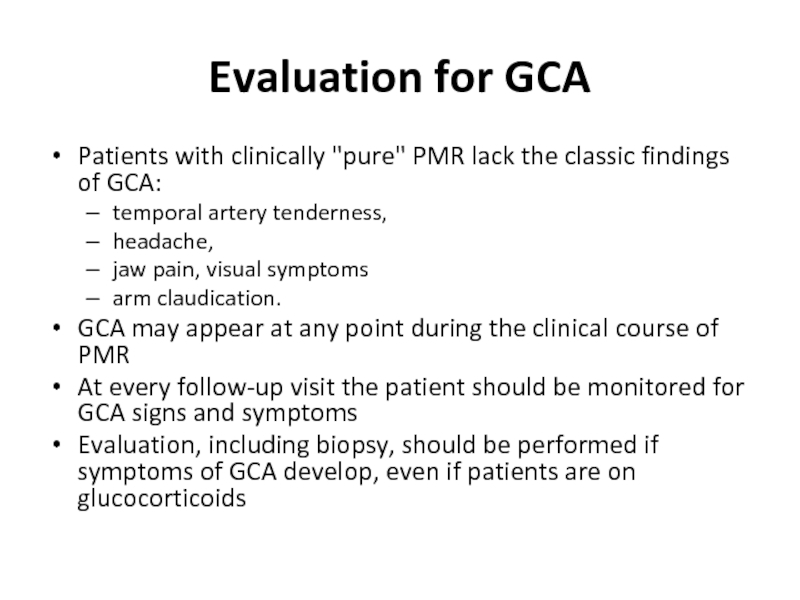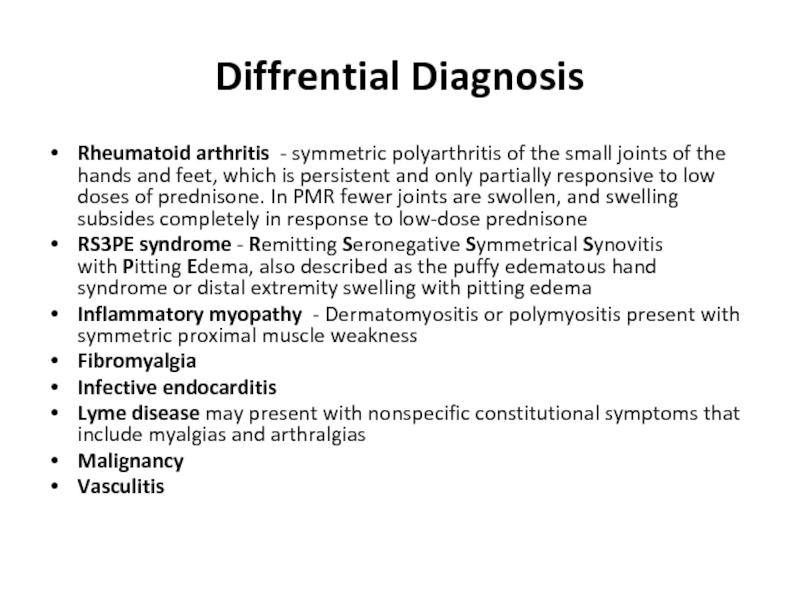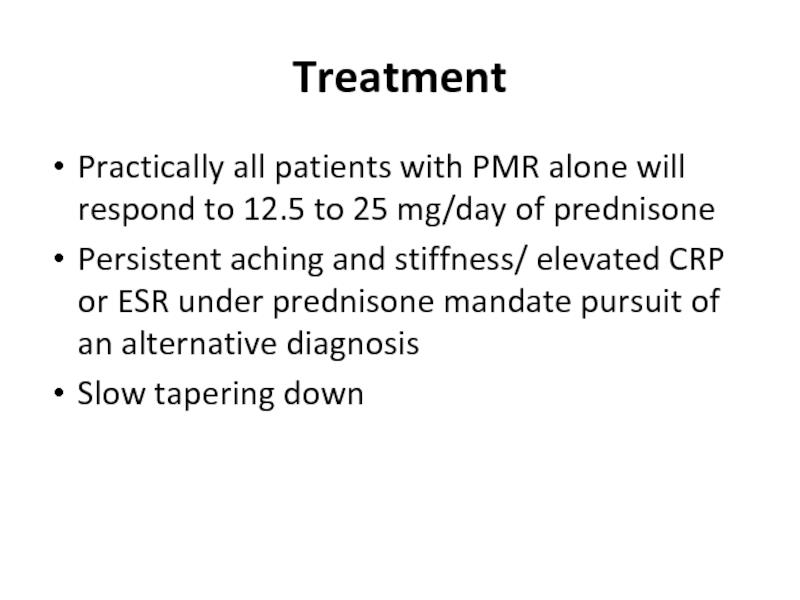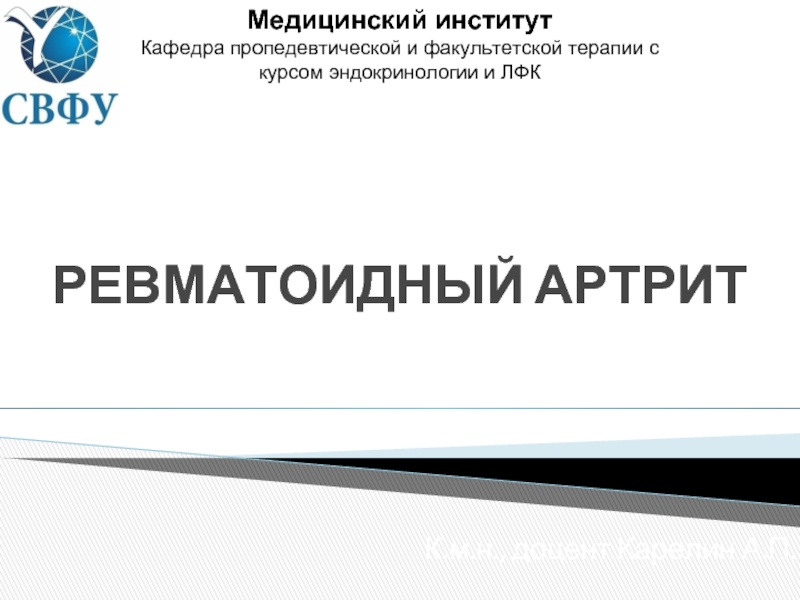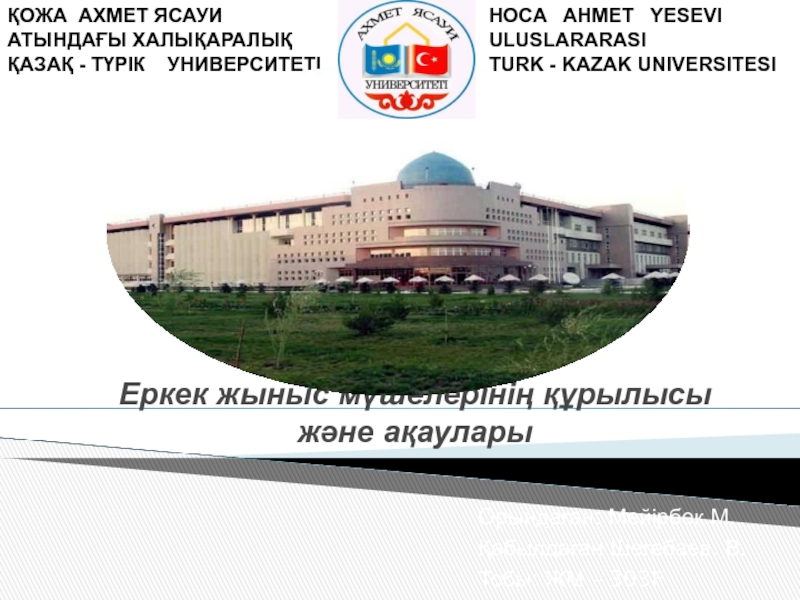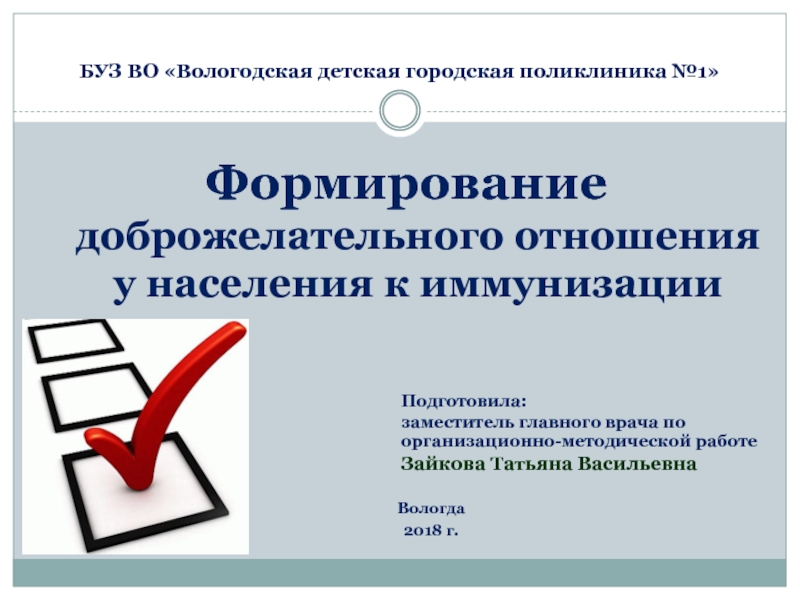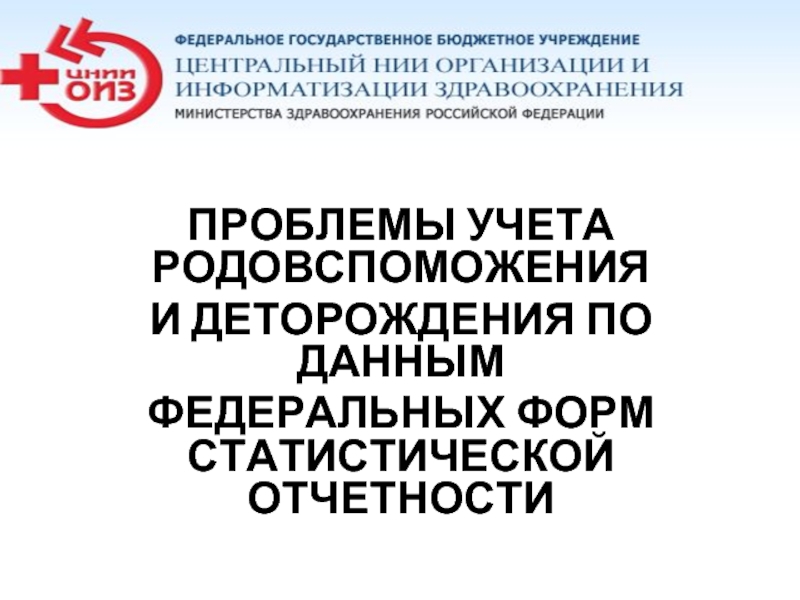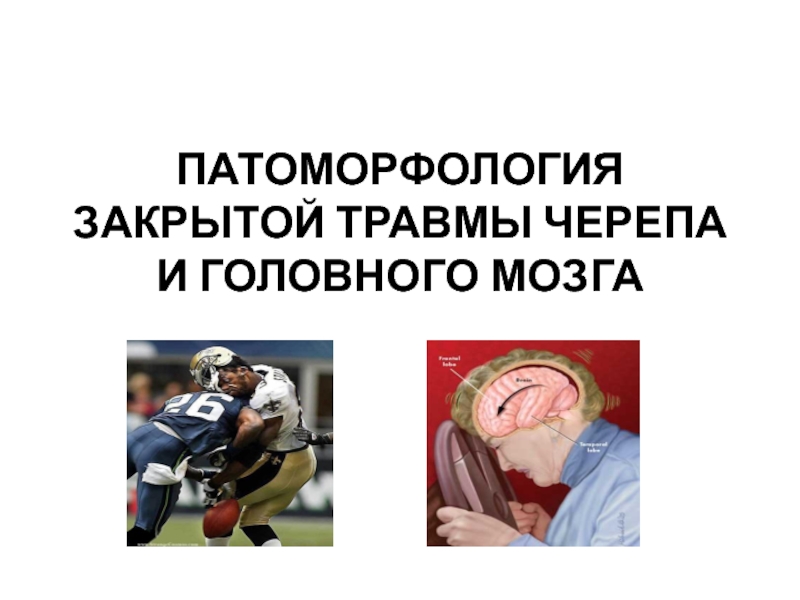- Главная
- Разное
- Дизайн
- Бизнес и предпринимательство
- Аналитика
- Образование
- Развлечения
- Красота и здоровье
- Финансы
- Государство
- Путешествия
- Спорт
- Недвижимость
- Армия
- Графика
- Культурология
- Еда и кулинария
- Лингвистика
- Английский язык
- Астрономия
- Алгебра
- Биология
- География
- Детские презентации
- Информатика
- История
- Литература
- Маркетинг
- Математика
- Медицина
- Менеджмент
- Музыка
- МХК
- Немецкий язык
- ОБЖ
- Обществознание
- Окружающий мир
- Педагогика
- Русский язык
- Технология
- Физика
- Философия
- Химия
- Шаблоны, картинки для презентаций
- Экология
- Экономика
- Юриспруденция
Polymyalgia rheumatica презентация
Содержание
- 1. Polymyalgia rheumatica
- 2. Introduction Polymyalgia rheumatica (PMR) is an inflammatory
- 4. Epidemiology Disease of adults over the age
- 5. Association with GCA PMR occurs in about
- 6. Pathogenesis The cause of polymyalgia rheumatica (PMR)
- 7. Signs and Symptoms Aching and morning stiffness
- 9. Signs and Symptoms Morning stiffness > 30
- 10. Signs and Symptoms Shoulder pain is more
- 11. Laboratory findings Elevated ESR, CRP (although can
- 12. Imaging Routine radiographs of inflamed joints do
- 13. Extra-articular involvement Biceps tenosynovitis subdeltoid bursitis
- 14. Evaluation of the patient Medical history Anemnesis
- 15. Diagnosis No pathognomonic test or established diagnostic
- 16. Evaluation for GCA Patients with clinically "pure"
- 17. Diffrential Diagnosis Rheumatoid arthritis -
- 18. Treatment Practically all patients with PMR alone
Слайд 2Introduction
Polymyalgia rheumatica (PMR) is an inflammatory rheumatic condition
Characterized clinically by :
aching
and morning stiffness in the shoulders, hip girdle, and neck.
It can be associated with giant cell (temporal) arteritis (GCA), and the two disorders may represent different manifestations of a shared disease process
It can be associated with giant cell (temporal) arteritis (GCA), and the two disorders may represent different manifestations of a shared disease process
Слайд 4Epidemiology
Disease of adults over the age of 50, with a prevalence
that increases progressively with advancing age
The peak incidence of PMR occurs between ages 70 and 80
PMR is relatively common. The lifetime risk of PMR is second only to rheumatoid arthritis (RA) as a systemic rheumatic disease in adults
Women are affected two to three times more often than men
Cases of familial aggregation are recognized
The incidence is highest in Scandinavian countries and in people of northern European descent
PMR appears to be uncommon in Asian, African-American, and Latino populations, though all racial and ethnic groups may be affected.
The peak incidence of PMR occurs between ages 70 and 80
PMR is relatively common. The lifetime risk of PMR is second only to rheumatoid arthritis (RA) as a systemic rheumatic disease in adults
Women are affected two to three times more often than men
Cases of familial aggregation are recognized
The incidence is highest in Scandinavian countries and in people of northern European descent
PMR appears to be uncommon in Asian, African-American, and Latino populations, though all racial and ethnic groups may be affected.
Слайд 5Association with GCA
PMR occurs in about 50% of patients with GCA
The percentage of patients with PMR who experience GCA at some point is ~10%
The two disorders may not be active synchronously
Слайд 6Pathogenesis
The cause of polymyalgia rheumatica (PMR) is unknown
Both environmental and genetic
factors appear to play a role
Both PMR and GCA are associated with specific alleles of human leukocyte antigen (HLA)-DR4
Some studies have suggested a cyclical pattern in incidence and seasonal variation
Both PMR and GCA are associated with specific alleles of human leukocyte antigen (HLA)-DR4
Some studies have suggested a cyclical pattern in incidence and seasonal variation
Слайд 7Signs and Symptoms
Aching and morning stiffness
Shoulders, hip girdle, neck, and
torso are involved
Patients over the age of 50
Symptoms are usually symmetric
Recent, discrete change in musculoskeletal symptoms
Patients over the age of 50
Symptoms are usually symmetric
Recent, discrete change in musculoskeletal symptoms
Слайд 9Signs and Symptoms
Morning stiffness > 30 minutes
Stiffness at the shoulders and
hips may cause trouble with dressing
Stiffness may be so severe that there is difficulty turning over in bed at night or arising from bed in the morning.
The ‘gel’ phenomenon, stiffness after inactivity, is often notably severe in PMR
An inability to actively abduct shoulders past 90 degrees because of stiffness is a typical finding
Stiffness may be so severe that there is difficulty turning over in bed at night or arising from bed in the morning.
The ‘gel’ phenomenon, stiffness after inactivity, is often notably severe in PMR
An inability to actively abduct shoulders past 90 degrees because of stiffness is a typical finding
Слайд 10Signs and Symptoms
Shoulder pain is more common at presentation than hip
pain
Pain is worse with movement and may interfere with sleep
Synovitis and bursitis - in peripheral joints, such as the knees, wrists, and MCPs
Synovitis and bursitis are thought to be the causes of the discomfort and stiffness
Swelling and tenosynovitis – Some patients develop swelling and pitting edema of the hands, wrists, ankles, and top of the feet
Tenosynovitis can also cause carpal tunnel syndrome
Decreased range of motion – There may be decreased active and passive range of motion of the shoulders, neck, and hips.
Muscle tenderness – not a prominent feature, and what tenderness there may be about the shoulders is more likely due to synovial or bursal inflammation than muscle involvement
Normal muscle strength
Systemic signs and symptoms – malaise, fatigue, depression, anorexia, weight loss, and low-grade fever.
Pain is worse with movement and may interfere with sleep
Synovitis and bursitis - in peripheral joints, such as the knees, wrists, and MCPs
Synovitis and bursitis are thought to be the causes of the discomfort and stiffness
Swelling and tenosynovitis – Some patients develop swelling and pitting edema of the hands, wrists, ankles, and top of the feet
Tenosynovitis can also cause carpal tunnel syndrome
Decreased range of motion – There may be decreased active and passive range of motion of the shoulders, neck, and hips.
Muscle tenderness – not a prominent feature, and what tenderness there may be about the shoulders is more likely due to synovial or bursal inflammation than muscle involvement
Normal muscle strength
Systemic signs and symptoms – malaise, fatigue, depression, anorexia, weight loss, and low-grade fever.
Слайд 11Laboratory findings
Elevated ESR, CRP (although can be normal)
Normocytic anemia
Thrombocytosis
Serologic tests, such
as ANA, RF, ACPA are typically negative
Increase in liver enzymes, especially alkaline phosphatase, although these abnormalities are more common in patients with GCA than PMR alone
Increase in liver enzymes, especially alkaline phosphatase, although these abnormalities are more common in patients with GCA than PMR alone
Слайд 12Imaging
Routine radiographs of inflamed joints do not show abnormalities in patients
with PMR
MRI and US can demonstrate synovial inflammation, with a predilection for extra-articular synovial structures (bursitis, tenosynovitis)
Synovitis is never erosive
MRI and US can demonstrate synovial inflammation, with a predilection for extra-articular synovial structures (bursitis, tenosynovitis)
Synovitis is never erosive
Слайд 14Evaluation of the patient
Medical history
Anemnesis
Physical examination
Assessment of the response to low-dose
glucocorticoids.
Symptoms are generally 50 to 70 % better within 3 days of prednisone (10 to 20 mg/day) and
Almost all patients respond completely within two weeks of initiation of therapy
MRI or US may be helpful to assess whether there is underlying bursitis or other evidence for inflammation
Symptoms are generally 50 to 70 % better within 3 days of prednisone (10 to 20 mg/day) and
Almost all patients respond completely within two weeks of initiation of therapy
MRI or US may be helpful to assess whether there is underlying bursitis or other evidence for inflammation
Слайд 15Diagnosis
No pathognomonic test or established diagnostic criteria for polymyalgia rheumatica (PMR)
Presence
of all of the following, after exclusion of alternative disease:
Age 50 years or older at disease onset
Proximally and bilaterally distributed aching and morning stiffness for at least two weeks
2/3 areas: neck or torso, shoulders or proximal regions of the arms, and hips or proximal aspects of the thighs
ESR ≥40 mm/h
Rapid resolution of symptoms with low-dose glucocorticoids.
Age 50 years or older at disease onset
Proximally and bilaterally distributed aching and morning stiffness for at least two weeks
2/3 areas: neck or torso, shoulders or proximal regions of the arms, and hips or proximal aspects of the thighs
ESR ≥40 mm/h
Rapid resolution of symptoms with low-dose glucocorticoids.
Слайд 16Evaluation for GCA
Patients with clinically "pure" PMR lack the classic findings
of GCA:
temporal artery tenderness,
headache,
jaw pain, visual symptoms
arm claudication.
GCA may appear at any point during the clinical course of PMR
At every follow-up visit the patient should be monitored for GCA signs and symptoms
Evaluation, including biopsy, should be performed if symptoms of GCA develop, even if patients are on glucocorticoids
temporal artery tenderness,
headache,
jaw pain, visual symptoms
arm claudication.
GCA may appear at any point during the clinical course of PMR
At every follow-up visit the patient should be monitored for GCA signs and symptoms
Evaluation, including biopsy, should be performed if symptoms of GCA develop, even if patients are on glucocorticoids
Слайд 17
Diffrential Diagnosis
Rheumatoid arthritis - symmetric polyarthritis of the small joints of
the hands and feet, which is persistent and only partially responsive to low doses of prednisone. In PMR fewer joints are swollen, and swelling subsides completely in response to low-dose prednisone
RS3PE syndrome - Remitting Seronegative Symmetrical Synovitis with Pitting Edema, also described as the puffy edematous hand syndrome or distal extremity swelling with pitting edema
Inflammatory myopathy - Dermatomyositis or polymyositis present with symmetric proximal muscle weakness
Fibromyalgia
Infective endocarditis
Lyme disease may present with nonspecific constitutional symptoms that include myalgias and arthralgias
Malignancy
Vasculitis
RS3PE syndrome - Remitting Seronegative Symmetrical Synovitis with Pitting Edema, also described as the puffy edematous hand syndrome or distal extremity swelling with pitting edema
Inflammatory myopathy - Dermatomyositis or polymyositis present with symmetric proximal muscle weakness
Fibromyalgia
Infective endocarditis
Lyme disease may present with nonspecific constitutional symptoms that include myalgias and arthralgias
Malignancy
Vasculitis
Слайд 18Treatment
Practically all patients with PMR alone will respond to 12.5 to
25 mg/day of prednisone
Persistent aching and stiffness/ elevated CRP or ESR under prednisone mandate pursuit of an alternative diagnosis
Slow tapering down
Persistent aching and stiffness/ elevated CRP or ESR under prednisone mandate pursuit of an alternative diagnosis
Slow tapering down
